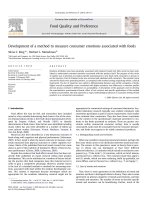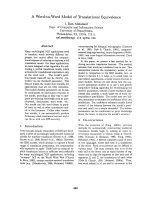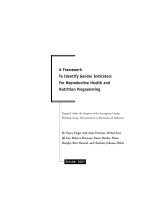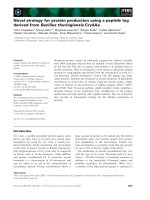Indicators for Soil Quality Defining a framework to measure soil quality (Romanyà et ppt
Bạn đang xem bản rút gọn của tài liệu. Xem và tải ngay bản đầy đủ của tài liệu tại đây (132.82 KB, 4 trang )
4. Indicators for Soil Quality
Defining a framework to measure soil quality (Romanyà et al.)
Romanyà J
1
, Serrasolses I
2
& Vallejo R.V.
1,2
1
Universitat de Barcelona
2
CEAM. Centro de Estudios Ambientales del Mediterráneo.
Soil provides a list of services to all users of terrestrial ecosystems and is crucial to our
agricultural societies. From an anthropogenic point of view, soil quality may be then measured
in terms of the services the soil provides to our society. The value of soil services to human
societies has changed during history and thus the value we give to soils has also changed over
time as it depends upon the economic and cultural basis of a society for a given context. While
throughout history human awareness of the soil services has been mainly reduced to food, fibre
and bioenergy production, nowadays the list of soil services has largely increased (see Table 1)
and we are beginning to realise that soil management is no longer a local but a global issue
affecting not only food and goods supplies but also to the human welfare and health. In other
words, this societal awareness of the multiple functions of soils is not limited to an specific land
use but to the whole landscape. Over the last century, as a result of the world increasing
population and soil products demand, soil use has been intensified throughout the world and
have promoted great scale changes in land use (agricultural land abandonment and urban
sealing in good lands in developed countries and deforestation in developing countries). In
developed countries increased forest land has been allocated to protect the environmental
quality (e.g. water catchments, biodiversity conservation, C sequestration). However, forest soils
in developed countries occupy less or much less than a 40 % of the land, and suffer a dramatic
reduction in the developing countries. In consequence, some authors have recently stated that
the protection of environmental quality and human health should be extensive to all land uses
including productive land as well (see Foley et al., 2005). In this context, to our point of view,
land management and planning should consider the ability of soils to function under different
land uses, the reversibility of any land use change and the multifunctionality of soils
(productivity, environment and human health). In consequence, the evaluation of soil quality
should address holistically the following three principles across all soil uses:
1. Food security (quality and quantity)
2. Environmental quality and biodiversity
3. Human health and welfare
Although none of these principles is solely dependant on soils they are all very much related to
soil functioning.
Soil quality assessment
Soil quality assessment typically includes the quantification of indicators that are often derived
from reductionist studies or general qualitative observations of the soil (Seybold et al., 1998).
Overall, soil quality indicators condense the enormous complexity of the soil (Schjonning et al.
2004) in an attempt to describe the capacity of the soil to function. In spite soil quality indicators
will not give a complete picture of the soil system we think they should attempt to cover, as
much as possible, all soil functions relevant to human life although the relative weight of each
one may change according to the land use and/or the environmental context. Thus, soil quality
indicators should address the most relevant threats to soils in a given context and should be
referred to their respective soil degradation thresholds. Soil degradation thresholds are specific
to soil type and environmental conditions and should also cover all soil functions. In figure 1 we
depict a framework for the establishment of soil quality indicators. Within this frame we first
define the general soil degradation thresholds and then at the local scale we also need to
address the specificity of the land management impacts, and define the threats associated to a
specific soil management. To do so we consider the management thresholds. According to
Schjonning et al. (2004) management thresholds can be defined as the most severe
disturbance any management may accomplish without inducing significant changes towards
unsustainable conditions. These management thresholds must consider the soil type and
environmental context that define the soil degradation context, may be specific to the soil use
and management context, and may thus stress one of the general soil functions but not forget
about the rest.
In table 2 we present a list of selected indicators that are often used for assessing soil quality. In
general these soil indicators are mainly related to soil productivity and only address the old
threats to soils (erosion, salinisation, loss of organic matter, compaction …). These soil quality
indicators hardly address the processes associated to the new threats to soil such as
contamination. Soil contamination is a highly complex issue to cope with chiefly when we
consider the multi-functionality of soils. Monitoring soil contamination can be addressed by risk
analysis however, this type of analysis is not a straightforward methodology to be applied to
soils as it includes toxicology studies for organisms (including humans) living in other
environmental compartments. Under these circumstances, a conservative record list of soil
inputs for traceability purposes should help assessing soil contamination issues. We think thus,
that when assessing soil contamination issues we should consider that the soil quality indices
monitoring the intrinsic soil function are not going to be comprehensive for many of the soil
contamination processes as they do not account for the effects of the pollutants transferred to
other environmental compartments.
References
Foley J.A., DeFries R., Asner D.F., Barford C., Bonan G., Carpenter S.R., Chapin F.S., Coe M.T., Daily
G.C., Gibss H.K., Helkowsky J.H., Holloway T., Howard E.A., Kucharik C.J., Monfreda C., Patz
J.A., Prentice C., Ramankutty N. and Snyder P.K. 2005. Global consequences of land use.
Science. 570-574.
Karlen D.L., Mausbach M.J., Doran J.W., Cline R.G., Harris R.F. and Schuman G.E. 1997. Soil quality: a
concept, definiton, and framework for evaluation. Soil Science Society of America Journal 61: 4-
10.
Schjonning P., Elmholt S. and Christensen B.T. 2004. Soil quality management. Concepts and terms. In:
Schjonning P., Elmholt S. and Christensen B.T. (eds.). Challenges in modern agriculture. CAB
International. pp 1-15.
Seybold C.A., Mausbach M.J., Karlen D.J. and Rogers H.H. 1998. Quantification of soil quality. In: Lal R.,
Kimble J.M., Follet R.F. and Stewart B.A. (eds.). Advances in Soil Science CRC Press. Boca
Raton. Florida pp. 387-404.
Table 1. List of main soil services.
Soil services to human society Major concerns
1. The base for terrestrial primary
production (agriculture and
forestry)
Productivity
2. Regional climate and air quality
regulation (carbon
sequestration)
Environment
3. Regulation of water quality and
supply
Environment
4. Habitat for many organisms
(biodiversity)
Environment
5. Natural system to recycle
organic matter and nutrients and
to prevent pathogen dispersion
(purifying capacity)
Environment
& Human Health
Table 2. Selected indicators of soil quality and some processes they impact (adapted
from Karlen et al., 1997).
Measurement Process affected
Organic matter Nutrient cycling, pesticide and water retention, soil structure
Infiltration Runoff and leaching potential, plant water use efficiency, erosion
potential
Aggregation Soil structure, erosion resistance, crop emergence, infiltration
pH Nutrient availability, pesticide absorption and mobility
Microbial
biomass
Biological activity, nutrient cycling, capacity to degrade pesticides
Forms of N Availability to crops, leaching potential, mineralisation and
immobilisation rates
Bulk density Plant root penetration, water- and air-filled pore space, biological
activity
Topsoil depth Rooting volume for crop production, water and nutrient availability
Conductivity or
salinity
Water infiltration, crop growth, soil structure
Available
nutrients
Capacity to support crop growth, environmental hazard
Soil surface Erosion, crusting, sealing, infiltration
Figure 1. Framework for establishing soil quality indicators.









